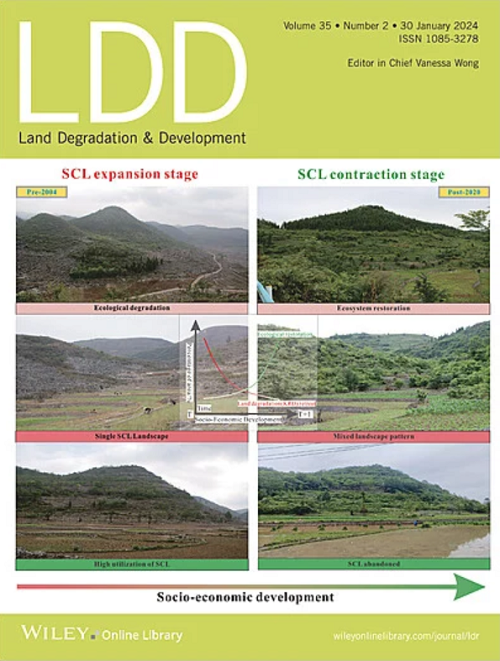印度西北部半干旱区地下水和沉积物中微塑料的分布、来源和重金属相互作用
IF 3.6
2区 农林科学
Q2 ENVIRONMENTAL SCIENCES
引用次数: 0
摘要
微塑料污染是一个日益严重的公共卫生问题,但它在地下水(一种重要的饮用水源)中的存在仍未得到充分研究。本研究调查了印度西北部拉贾斯坦邦迪德瓦纳-库查曼半干旱地区开放式和封闭式水井系统地下水中的MPs,以及沉积物样本中的MPs。利用荧光显微镜鉴定的MPs在所有采样点普遍存在,地下水浓度范围为3至122颗粒/L(平均为35.46颗粒/L),沉积物丰度范围为170至1140颗粒/kg(平均为505.52颗粒/kg)。形貌上,粒径在20 ~ 200 μm范围内的微球/微球以MP样品为主,聚乙烯和聚苯乙烯为主要聚合物类型。沉积物中MP浓度与裸井样品之间存在显著的正相关(r = 0.65),在垃圾填埋场和农业区附近观察到最高的值。地下水样品中重金属(HMs)浓度(ppb)的排序为:As (396.11) > Mn (280.18) > Zn (184.67) > Co (71.8) > Ni (60.56) > Pb (24.24) > Cr(1.26)。儿童和成人的危害商数均为As >; Mn > Pb > Co,明显高于可接受阈值(HQ > 1),表明存在较大的污染风险。虽然在水样中没有观察到MPs和HMs之间的显著相关性,但SEM-EDX分析揭示了HMs(包括Ni, As, Co, Cr, Zn, Mn和Pb)在MP表面的粘附性,这表明了潜在的相互作用和共同运输机制。研究结果强调了地下水中MPs和HMs的共存,引起了对潜在协同健康影响的担忧。这项研究强调了迫切需要进行全面的风险评估和缓解战略,以解决关键地下水资源中MP和HM污染的问题。本文章由计算机程序翻译,如有差异,请以英文原文为准。
Distribution, Sources, and Heavy Metal Interactions of Microplastics in Groundwater and Sediment of Semi-Arid Regions of Northwest India
Microplastic (MP) pollution is a growing public health concern, yet its presence in groundwater, a critical potable water source, remains underexplored. This study investigates MPs in groundwater from open and closed well systems, as well as in sediment samples, in the semi-arid region of Didwana-Kuchaman, Rajasthan, Northwest India. The MPs, identified using a fluorescence microscope, were ubiquitous at all sampling sites, with groundwater concentrations ranging from 3 to 122 particles/L (average = 35.46 particles/L) and sediment abundance ranging from 170 to 1140 particles/kg (average = 505.52 particles/kg). Morphologically, beads/pellets within the 20–200 μm size range dominated the MP samples, while polyethylene and polystyrene were identified as the dominant polymer types. A significant positive correlation (r = 0.65) between MP concentration in the sediment and open-well samples was noted, with the highest values observed near landfills and agricultural areas. Heavy metals (HMs) concentrations (ppb) in groundwater samples were ranked in the following order: As (396.11) > Mn (280.18) > Zn (184.67) > Co (71.8) > Ni (60.56) > Pb (24.24) > Cr (1.26). The hazard quotient derived for both children and adults indicates As > Mn > Pb > Co, significantly above the acceptable threshold (HQ > 1), suggesting a considerable contamination risk. Although no significant correlation was observed between MPs and HMs in the water samples, SEM–EDX analysis revealed the adherence of HMs, including Ni, As, Co, Cr, Zn, Mn, and Pb, to MP surfaces, suggesting potential interactions and co-transport mechanisms. The results underscore the concerning co-occurrence of MPs and HMs in groundwater, raising alarming concerns about potential synergistic health effects. This study highlights the urgent need for comprehensive risk assessments and mitigation strategies addressing MP and HM contamination in critical groundwater resources.
求助全文
通过发布文献求助,成功后即可免费获取论文全文。
去求助
来源期刊

Land Degradation & Development
农林科学-环境科学
CiteScore
7.70
自引率
8.50%
发文量
379
审稿时长
5.5 months
期刊介绍:
Land Degradation & Development is an international journal which seeks to promote rational study of the recognition, monitoring, control and rehabilitation of degradation in terrestrial environments. The journal focuses on:
- what land degradation is;
- what causes land degradation;
- the impacts of land degradation
- the scale of land degradation;
- the history, current status or future trends of land degradation;
- avoidance, mitigation and control of land degradation;
- remedial actions to rehabilitate or restore degraded land;
- sustainable land management.
 求助内容:
求助内容: 应助结果提醒方式:
应助结果提醒方式:


